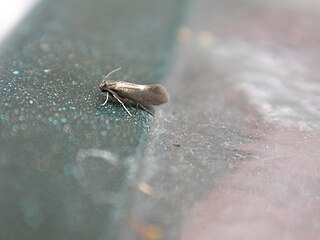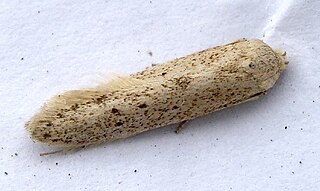
Cossoidea is the superfamily of moths that includes carpenter moths and relatives. Like their likely sister group Sesioidea they are internal feeders and have spiny pupae with moveable segments to allow them to extrude out of their exit holes in stems and trunks during emergence of the adult.

A family of primitive monotrysian moths in the order Lepidoptera, Heliozelidae are small, metallic day-flying moths with shiny smooth heads. In Europe the small adult moths are seldom noticed as they fly quite early in the spring. The larvae are leaf miners and the vacated leaf mines are distinctive because the larva leaves a large hole at the end.

Bryotropha is a genus of the twirler moth family (Gelechiidae). Among these, it is placed in the tribe Anomologini of subfamily Gelechiinae; the tribe was formerly considered a distinct subfamily Anomologinae.

Megacraspedus is a genus of moths in the family Gelechiidae, found primarily in the Palearctic.

Pseudotelphusa is a genus of moths in the family Gelechiidae.

Psoricoptera is a genus of moths in the family Gelechiidae. The genus was erected by Henry Tibbats Stainton in 1854.

Scrobipalpa is a genus of moths in the family Gelechiidae. Euscrobipalpa has sometimes been treated as a distinct subgenus, or even as a full genus, but is generally no longer recognised as valid, following Ponomarenko & Park (2007).

Teleiodes is a genus of moths in the family Gelechiidae.

Xenolechia is a genus of moth in the family Gelechiidae.

Blastobasis is the type genus of the gelechioid moth family Blastobasidae; in some arrangements these are placed in the case-bearer family (Coleophoridae) as a subfamily. Within the Blastobasidae, the subfamily Blastobasinae has been established to distinguish the Blastobasis lineage from the group around Holcocera, but the delimitation is not yet well-resolved.

Argyresthiidae is a family of moths known as the shiny head-standing moths. It was previously treated as a subfamily of Yponomeutidae.
Psoricoptera speciosella is a moth of the family Gelechiidae first described by Karl August Teich in 1892. It is found from northern and central Europe south to France, northern Italy and Romania. It is also found in the European part of Russia, Siberia, the Russian Far East and Japan.

Psoricoptera gibbosella, the humped crest, is a moth of the family Gelechiidae. It is widely distributed in Europe. Outside of Europe, it is found in Turkey, North Africa, China, Japan, Korea, Siberia and the Russian Far East. The habitat consists of mature woodlands.

Gelechiinae is a subfamily of moths in the family Gelechiidae. It was described by Henry Tibbats Stainton in 1854.
Mirificarma pederskoui is a moth of the family Gelechiidae. It was described by Peter Huemer and Ole Karsholt in 1999. It is found in southern Spain.
Neofriseria baungaardiella is a moth of the family Gelechiidae. It was described by Peter Huemer and Ole Karsholt in 1999. It is found in Greece, southern Spain and Portugal.
Psoricoptera latignathosa is a moth of the family Gelechiidae. It was described by Kyu-Tek Park and Ole Karsholt in 1999. It is found in China and Korea.
Psoricoptera arenicolor is a moth of the family Gelechiidae. It was described by Omelko in 1999. It is found in the Russian Far East, where it has been recorded from south-eastern Siberia and Sakhalin.










